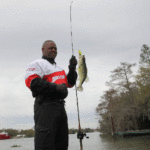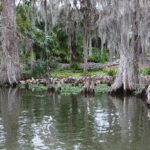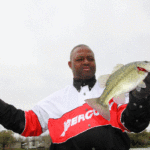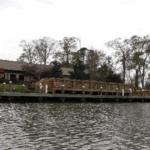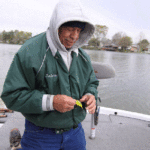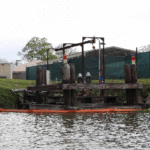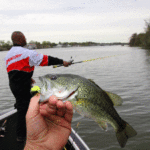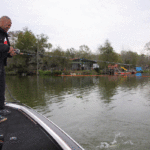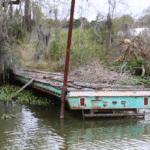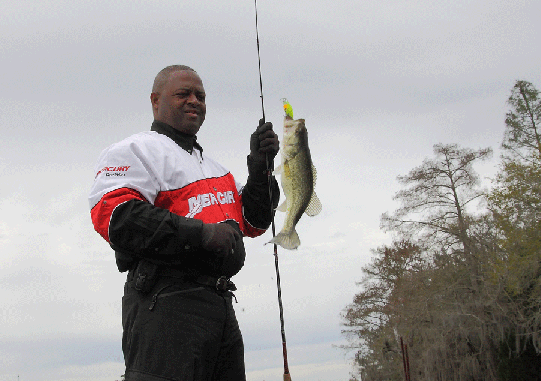
Few places get fished more heavily than Bayou Teche, but that’s because it always seems to deliver the goods.
Bayou Teche starts in Port Barre and runs 125 miles to the Atchafalaya River in Berwick Bay. But it’s the 8- to 9-mile stretch of bayou between the East Calumet Spillway locks and the Berwick Bay Locks at the Atchafalaya River that competitive anglers know is the place where they can always find five good fish to put on the scale. Franklin resident Gary Foulcard, a member of Bullet Bass Club, is one of those club anglers who fishes in the Teche several times throughout the year.
The former special-needs school teacher, now UPS driver, says there are certain times throughout the year when conditions outside the locks in the surrounding Atchafalaya Basin or coastal waters in the marsh prevent bass anglers from catching limits.
“I’ll fish the Teche five or six times a year,” he said. “The Teche is always a go-to location for club anglers. You don’t always catch big fish, but usually plenty. When the water is low or high in the surrounding area or impacted by weather, conditions are almost always the same on the Teche, because the locks are closed.
“Sometimes on the outside, windy days can be brutal — getting into the Teche can be a welcomed reprieve from the elements. Plus, the water is usually always clear, where outside of the locks it may be stained or really dirty.”
The truth is, it was some of those go-to bass in the Teche that found Foulcard and me banging a few crankbaits off some cypress stumps and any other submerged structure that we thought looked good during a chilly spring morning this year.
Typically, when a cold front passes through and the bass catch a case of lockjaw, it’s not always the best conditions to be fishing any species. Bass can be some hard cases.
However, the one thing that works against bass is they can be agitated into biting when they don’t necessarily want to. Additionally, during the spawn in early spring, protecting the nest is another reason they can be coerced into biting.
Leaving the Patterson boat launch located on Highway 182 near Patterson High School, we didn’t expect much because of the weather conditions. UPS drivers can’t always pick the days they want to fish. Like most weekend warriors, they only get Saturday and Sunday to try and squeeze in a fishing trip. It all boils down to several choices, all of which may include chores, watching NASCAR or catching up on rest. Foulcard and his club members usually choose to fish one of those days.
Running a couple miles east, near Patterson City Hall, we started trolling the woods farther off the bank than I expected. In spite of the fact that we were making some pretty long casts, it wasn’t long before I set the hook on a small bass that didn’t quite make the 14-inch minimum required by law to put in the live well. So, like a pro, I released the fish.
“Most of the time you’ll catch your fish in 6 to 8 feet of water throughout the year,” Foulcard said, explaining why he prefers to fish quite a ways off the bank initially. “I’ll start out with a crankbait because I’m trying to do a couple things. It helps me see what depth the fish are at, and it helps me form a pattern. But, what makes crankbaits good to start with is that the Teche has a lot of shad in it. By getting out away from the bank, you can catch those bass right at the drop off.”
I happened to nail a good 4-pound blue catfish on my crankbait that, yes, went into the livewell to take home to eat. Who can resist catfish fillets either blackened in a fry pan or baked in the oven? But it was while cleaning it that I noticed its stomach was bulging. I had to investigate.
A lot can be learned when examining stomach contents, where sure enough, Foulcard was correct in his assessment. The catfish had been gorging itself on shad. My crankbait passing by apparently was more than it could resist.
Foulcard, 48, who’s also the baby of the family, grew up fishing with his dad and older brother Gerald, noting it became instilled in both of them.
Anglers who decide to fish Bayou Teche will find there is no shortage of structure that will hold fish. Moreover, the Teche can also be thought of as having two sides, the city side and the woods side.
The city side consists of beautiful homes with bulkheads, wharfs, floating docks, pavilions, riprap and boat sheds. During hot spring and summer days, bass will get up under these structures and take refuge.
The city side is also the side where in late March and on into April the fish will spawn, making much of the manmade structure high-probability target areas anglers shouldn’t pass up.
While fishing, our paths happened to cross with Jim Davidson who does a Friday morning fishing report on television.
“The bigger fish are caught on the city side early because they spawn more on that side,” he said. “The later it gets in the spring then you want to go to the woods side.”
What’s more, Davidson pointed out anglers should fish riprap wherever they find it and the plethora of wooden structure the city side offers.
Foulcard mentioned when he fishes the city side he has had more success when fishing older structure.
“I’ll fish the older wooden structure that has been there a while rather than new structure built from pressure-treated lumber that still has the green color on it,” he said. “I find fish hang around the older structure more.”
The woods side of the Teche offers that notable picturesque view found throughout the Atchafalaya Basin, albeit in a condensed version. The few homeowners along the woods side readily take advantage of that beauty by incorporating it in their landscape providing a more natural setting.
But it’s the structure on the wood side consisting of submerged stumps, sunken logs, cypress trees, cypress knees, brushy banks and trees whose branches touch the water where bass congregate.
The woods side of Bayou Teche also has long stretches of submerged grass. Foulcard and I tossed our crankbaits close to the bank, and as they left the grass, dropping off into the 6-foot depth, is when our best bites occurred. There, and also submerged logs.
I wanted to try out Rebel Lures’ new Crappie Crank R baits that are designed more for trolling. I knew with its longer bill it would work well along deeper bayous and canal banks, when cast with a rod and reel.
Flipping perpendicular behind a semi-submerged log in clear water, I let the bait float until the rings from the splash drifted away. Reeling the lure quickly caused it to dive deep; just as it reached the log, it exploded. The bass flipped over the log to my side, trying to throw the bait.
Bites like that get young and old excited. Bayou Teche’s protected waters inside the locks also make it a place to teach youngsters.
“You do catch a lot of small fish when the bite is on in the Teche, but it’s still fun,” said Foulcard. “That’s what makes it a good place to bring young ones who might want to get into fishing.
“It’s a great place to take the family and teach kids to fish.”
When tournament season gets into full swing, it’s not uncommon to see dozens and dozens of bass boats trolling the Teche like aircraft circling an airport in a holding pattern to land. Quite often, locals see bass boats leaving with fish to take to a weigh-in somewhere that don’t go back into the system, raising concern.
However, according to Louisiana Department of Wildlife and Fisheries biologist Tim Morrison, perception doesn’t always provide the complete picture.
“There is no scientific data that we can refer to that suggests there is an impact when tournament anglers remove fish,” he told me years ago. “Just look at the number of recreational anglers — and they are taking limits of fish. What most people see from tournament bass anglers is one large lump of fish being removed.”
The bigger impact, if any at all, may be from industry and development. Most homeowners tend to install bulkheads along their shorelines, and watersheds that once flooded during the spring, where fish could spawn, now are designed to drain fields rapidly.
The truth is, with both tournament and recreational anglers fishing Bayou Teche between Calumet and Berwick, it remains a go-to place that continues to produce bass.
Other baits anglers should consider using on Bayou Teche are Texas-rigged soft plastics like Wave’s Super Soft Pro or Stanley Sidewinder. Creature soft-plastic baits that resemble crawfish like Berkley Havoc designs, Stanley Itza Bug and Baby Bush Hogs are all good. And never underestimate a lizard, especially during the spawn.
Go-to colors that are good in the Teche include black/blue, watermelon/red flake and pumpkin with black and purple flake.
“Most of the local club tournament guys fish the marsh in February and March, where the fish spawn a bit earlier,” said Foulcard. “I guess the deeper water in the Teche warms up later, because in late March and April it starts getting good and is when you want to be fishing it.”
